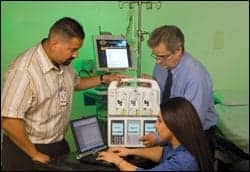 |
| Raymond Peter Zambuto |
Three years ago, 24×7 began a column called “Tech Talk” by Dennis Minsent, MSBE, CCE, CBET, director, clinical technology services, Oregon Health & Science University, Portland, Ore, to give a monthly capsulation of different aspects of the IT side of medical devices and technology. In August 2007, the column was extended to include a number of rotating authors—each having a particular experience and expertise to share—and the column was appropriately renamed “Networking.” (See editor’s note.)
Over the 3-year period since we began, we have seen many changes in the health care technology landscape. Much of this has been chronicled, with columns on education, connectivity, the CE-IT “interface,” and the impact of regulations and proposed standards on what we do. In that time, it has also become apparent that the IT side of clinical engineering will not be a sideline, but a significant addition to the body of knowledge, job descriptions, and career paths of those of us who work in, or for, the health care industry.
Much focus has been placed on the issues associated with connectivity and the interoperability of medical equipment. The Health Information Technology for Economic and Clinical Health Act (HITECH), which is part of the Obama administration’s economic stimulus program, has raised the stakes for the deployment of electronic medical records (EMR), a part of which will include the direct inputting of patient-generated data into the EMR. The aggressive timetable to accomplish this, 2013 to 2015, may or may not be achievable.
 |
Certainly, the high levels of activity at Integrating the Healthcare Enterprise (IHE) International, the Continua Health Alliance, and the MDPnP program at the Center for Integration of Medicine and Innovative Technology, and the more recent collaborations among these groups, gives testimony to the magnitude of the tasks ahead. It is likely, in the near term, that while some health care settings will be able to use an interoperable system, others will opt for a single source/vendor solution, or “one-off” customized interfaces, to achieve connectivity. Regardless of the solution chosen, the system integration and ongoing support of that equipment will require that clinical engineering have a working knowledge and expertise with these systems, and a workable interface with the facility’s IT department.
Joining Forces
Developing a successful CE-IT relationship requires, first and foremost, open communication. Open dialogues and forums to explore the similarities and differences between CE and IT, to consider best practices across both domains, and to look at methods of cooperation and relationships, have grown significantly of late. Three societies have been particularly responsive to filling this need: The American College of Clinical Engineering (ACCE), the Healthcare Information and Management Systems Society (HIMSS), and the Association for the Advancement of Medical Instrumentation (AAMI).
The three societies formed the CE-IT Community in 2008 as a culmination of initiatives from earlier years. The community has a number of active projects that are now generating deliverables in areas such as best practices and CE-IT resources. The HIMSS-ACCE-sponsored Excellence in CE-IT Synergies Award is a major recognition, now in its fourth year, and the three societies co-sponsor an annual CE-IT preconference symposium at the HIMSS annual meeting, which has consistently sold out. For 2010, the symposium will focus on “Collaboration in a Time of Change,” looking at the impact of HITECH and other change agents on the relationships between clinical engineering and IT. Special publications from AAMI, such as IT Horizons, and a focus by top leadership of all three societies on the CE-IT interface, underscore the seriousness of the commitment that each has to this area.
Beyond these traditional channels, additional activity is occurring across the country. Tim Gee, at Medical Connectivity Consulting, Beaverton, Ore, organized a 2-day conference this fall that brought more than 200 professionals from industry, health care, and academia together to discuss medical device connectivity, including the impact of HITECH, the regulatory picture, the changes in risk associated with connectivity, and the costs of implementing and sustaining connected systems. In September, the northeast biomedical managers of the VA jointly held a seminar with independent service organization Technology in Medicine, Holliston, Mass, to gain varied perspectives on connectivity.
Recognizing Common Goals
At these grassroots presentations, as well as in the activities of the major societies, a common theme is the impact on clinical engineering jobs. The emerging standard IEC 80001 for the application of risk management to IT networks incorporating medical equipment and The Joint Commission’s Sentinel Event Alert, Issue 42, December 11, 2008, “Safely Implementing Health Information and Converging Technologies,” have, in part, driven the exploration of new roles in clinical engineering.
Modified job descriptions often emphasize clinical systems engineering. Additionally, the clinical engineer is sometimes the default monitor for risk mitigation at the point of care. This includes the monitoring of human factors from information overload; caregiver errors induced by workflow changes; and the tracking/inventorying of connected device software, versions, and patches.
All of what has happened to date is the first wave of changes for clinical engineering and IT. As the technology continues to converge, clinical engineering and IT must continue to collaborate. The two fields have “grown up” in health care at about the same time, but from very different backgrounds. Clinical engineering came out of patient care and its technology, and the needs and mandates that surround its support. IT arose from business systems and has approached the clinical side through the linkage of medical records and payment systems. Each has a different perspective—one being oriented to the individual care episode, the other to a view at the systems level.
As they come together to join forces, these cultural differences can lead to conflict. It is important as the professions consider their developing relationship that each respects the other’s culture. The clinical engineering approach simply will not work well in the well-organized mission-critical world of IT, and the IT approach will be equally ineffective in the life-critical world of clinical support.
Much has been made of the potential that clinical engineering will become subsumed by the much larger IT department, losing its unique identity. In 2007, the Gartner Group consulting organization postulated a large-scale merging of CE into IT. To date, there is no objective evidence to point to one structural approach being better or worse than another. It is most likely that individual hospitals will do what works best for their individual situation.
Alternately, as the criticality of the IT network continues to increase and the lines between logical networks carrying clinical information and business data begin to blur, there may be a point at which the network management, both hardware and software, begins to separate from the applications side of IT. Potential FDA action in regard to the network as a medical device becomes more likely as patient care becomes more dependent upon reliable transmission of data.
|
Read past Networking articles in the archives. |
As the ability to recall information from the EMR becomes common practice in care, as plug-and-play equipment implements smart alarms or safety interlocks by communication with other devices, and as alarm management requires reliable network communication of signals direct to caregivers, the integrity of the network will become critical to care. At some point, the network will cross the line to be regarded by the regulation or accreditation community as a utility essential to patient care and safety.
If that occurs, the overall management of technology in the hospital may well separate from IT, leaving IT as a manager of information applications. Within a technology management structure, clinical engineering will play a pivotal role. While it remains to be seen how the future will play out, one thing is certain, and that is the continuing need for clinical engineering to network. Here in the “Networking” column, we look forward to continuing to chronicle, advise, and feed forward information on the trends, changes, and sentinel events that affect the clinical engineering profession’s interface with IT.
(Editor’s note: The new name for the column was suggested by reader John Dinsmore, GS10, DAC, biomedical equipment maintenance branch, Womack Army Medical Center, Ft Bragg, NC.)
Raymond Peter Zambuto, CCE, FASHE, FHIMSS, FACCE, is president of Linc Health LLC, Holliston, Mass, and is a member of 24×7’s editorial advisory board. For more information, contact .
Following the Path
Explore the many organizations discussed in the article that support the efforts of clinical/biomedical engineers, and also those that are working toward connectivity and interoperability with a collaborative spirit.
- The Health Information Technology for Economic and Clinical Health Act (HITECH): www.opencongress.org/bill/111-s350/show or waysandmeans.house.gov/media/pdf/110/hit2.pdf
- Integrating the Healthcare Enterprise International (IHE): www.ihe.net
- The Continua Health Alliance: www.continuaalliance.org
- The MDPnP program at the Center for Integration of Medicine & Innovative Technology (CIMIT): www.cimit.org
- The American College of Clinical Engineering (ACCE): www.accenet.org
- The Healthcare Information and Management Systems Society (HIMSS): www.himss.org
- The Association for the Advancement of Medical Instrumentation (AAMI): www.aami.org
- The CE-IT Community: www.ceitcollaboration.org
- Medical Connectivity Consulting: www.medicalconnectivity.com
- Technology in Medicine: www.techmed.com
- The IEC, for information on the emerging standard 80001: www.iec.ch
- The Joint Commission’s Sentinel Event Alert, Issue 42, December 11, 2008, “Safely Implementing Health Information and Converging Technologies”: www.jointcommission.org/SentinelEvents/SentinelEventAlert/sea_42.htm





